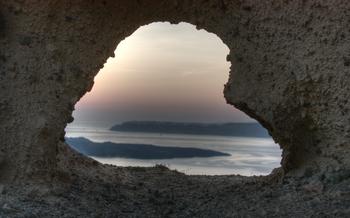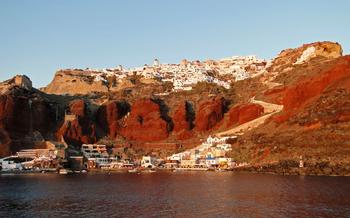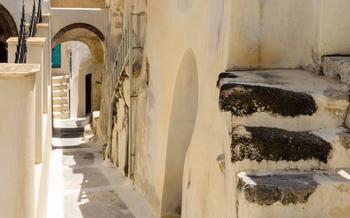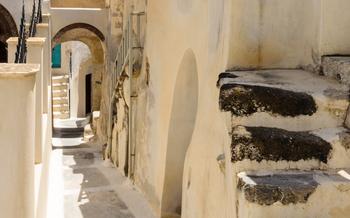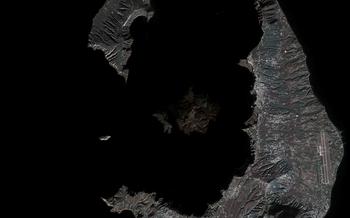
The Wall Paintings of Thira Exhibition
- The Wall Paintings of Thira Exhibition: A Journey into Ancient Art
- Unveiling the Wonders of Akrotiri
- Exploring the Frescoes: A Vivid Glimpse into Minoan Life
- The Thera Explosion and Its Aftermath
- Akrotiri's Connection to Minoan Crete
- Museum Highlights: Must-See Masterpieces
- Interactive Displays and Educational Opportunities
- Transportation Options: Getting to the Exhibition
- Nearby Attractions: Exploring Santorini's Treasures
- Recommended Restaurants: Savoring Local Cuisine
- Accommodation Options: Finding Your Perfect Stay
- Safety and Security: Ensuring a Hassle-Free Trip
- Cultural Etiquette: Respecting Local Customs
- Insider Tip: Discovering Hidden Gems
The Wall Paintings of Thira Exhibition: A Journey into Ancient Art
The Wall Paintings of Thira Exhibition in Santorini, Greece, offers a captivating journey into the world of ancient Minoan art. Located in the picturesque village of Fira, this exhibition showcases a remarkable collection of frescoes and artifacts unearthed from the archaeological site of Akrotiri, an ancient Minoan settlement buried under volcanic ash during a catastrophic eruption. The exhibition provides a unique opportunity to explore the vibrant culture and artistic achievements of the Minoan civilization, shedding light on their daily lives, beliefs, and connection to the wider ancient world.
Unveiling the Wonders of Akrotiri
Akrotiri, an ancient city buried under layers of volcanic ash, stands as a testament to the rich history and culture of the Minoan civilization. Once a thriving settlement, Akrotiri was tragically destroyed by a volcanic eruption that occurred around 1627 BC. The catastrophic event preserved the city remarkably well, providing archaeologists with an invaluable glimpse into Minoan life.
Excavations at Akrotiri began in the 1960s and have continued to uncover a wealth of artifacts, including well-preserved buildings, intricate frescoes, and everyday objects. The settlement's layout, with its paved streets, multi-story buildings, and advanced drainage system, highlights the sophistication of Minoan urban planning.
The volcanic eruption that buried Akrotiri also sealed its fate, protecting it from the ravages of time. The ash and pumice that engulfed the city acted as a natural preservative, allowing the frescoes and other delicate artifacts to survive for millennia. The remarkably preserved state of Akrotiri has earned it the title of the "Minoan Pompeii," drawing comparisons to the famous Roman city that was buried by the eruption of Mount Vesuvius.
Akrotiri's exceptional preservation provides a unique opportunity to study Minoan culture and art. The frescoes that adorn the walls of the buildings offer insights into the daily lives, religious beliefs, and artistic traditions of the Minoans. These vibrant and detailed paintings depict scenes of hunting, fishing, religious rituals, and everyday life, providing a glimpse into a civilization that flourished thousands of years ago.
Exploring the Frescoes: A Vivid Glimpse into Minoan Life
The Wall Paintings of Thira Exhibition showcases a remarkable collection of frescoes, offering a vibrant glimpse into the daily life and cultural practices of the ancient Minoans. These exquisite artworks, created using a variety of techniques and materials, depict a wide range of subjects, from religious rituals and ceremonies to scenes of hunting, fishing, and everyday life.
The frescoes are renowned for their intricate details, vivid colors, and symbolic representations. They provide valuable insights into the Minoan civilization, their beliefs, and their way of life. The "Spring Fresco," for example, portrays a lush landscape teeming with flowers, birds, and insects, symbolizing the renewal of life and the arrival of spring.
Another highlight is the "Flotilla Fresco," which depicts a fleet of ships sailing across the sea, showcasing the Minoans' maritime prowess and their extensive trading network. These frescoes not only serve as beautiful works of art but also offer a unique window into the rich cultural heritage of the Minoan civilization.
The Thera Explosion and Its Aftermath
The eruption of Thera, also known as the Minoan eruption, was a cataclysmic event that occurred around 1600 BCE and had a profound impact on the Minoan civilization and the wider region. The eruption, which is believed to have been one of the largest in history, released an enormous amount of ash and pumice into the atmosphere, causing widespread destruction and devastation. The ash cloud reached as far as Egypt and Anatolia, and the resulting tsunamis devastated coastal settlements throughout the Mediterranean.
Archaeological evidence suggests that the eruption was sudden and violent, with the entire island of Thera being engulfed in ash and pumice within a matter of hours. The city of Akrotiri was buried under meters of debris, and its inhabitants were either killed by the eruption itself or by the subsequent tsunamis. The eruption also caused widespread damage to other Minoan settlements on Crete and the surrounding islands.
The Thera eruption had a profound impact on the Minoan civilization. The loss of Akrotiri, which was one of the most important Minoan cities, was a major blow, and the eruption also disrupted trade and communication routes between Crete and the rest of the Mediterranean. The Minoan civilization eventually declined and was eventually replaced by the Mycenaean civilization.
The exact cause of the Thera eruption is still debated, but it is believed to have been triggered by a combination of factors, including the movement of tectonic plates, the accumulation of magma in the volcano, and the presence of seawater in the volcano's caldera. The eruption was so powerful that it caused the collapse of the volcano's caldera, creating the Santorini caldera that we see today.
Akrotiri's Connection to Minoan Crete
Akrotiri and Minoan Crete shared deep cultural and economic ties. Both civilizations flourished during the Bronze Age and exhibited remarkable parallels in their art, architecture, and way of life. Minoan influence can be seen in Akrotiri's magnificent frescoes, which depict scenes from daily life, religious ceremonies, and maritime activities. These vibrant and detailed paintings reveal a society that was highly skilled in artistic expression and storytelling.
The similarities between Akrotiri and Minoan Crete extend beyond their artistic traditions. Both civilizations developed advanced systems of writing, indicating a shared intellectual and cultural heritage. In addition, archaeological evidence suggests that Akrotiri and Crete engaged in extensive trade and exchange, further strengthening their interconnectedness.
While Akrotiri had its unique characteristics and local developments, it remained firmly rooted in the broader Minoan world. The connections between these two civilizations provide valuable insights into the cultural and historical dynamics of the Bronze Age Aegean. By exploring Akrotiri's frescoes and understanding its relationship with Minoan Crete, visitors can gain a deeper appreciation for the rich and interconnected tapestry of ancient Mediterranean civilizations.
Museum Highlights: Must-See Masterpieces
The Wall Paintings of Thira Exhibition houses a remarkable collection of artifacts and frescoes that offer a glimpse into the vibrant Minoan civilization. Among the highlights of the museum are:
-
The "Spring Fresco": This iconic fresco depicts a lush landscape with flowers, birds, and butterflies, symbolizing the arrival of spring. It is considered one of the finest examples of Minoan art and a testament to their mastery of naturalism.
-
The "Flotilla Fresco": This impressive fresco showcases a fleet of Minoan ships sailing across the sea, accompanied by dolphins and fish. It provides valuable insights into the maritime activities and trade networks of the Minoan civilization.
-
"The Boxer Fresco": This unique fresco portrays two young men engaged in a boxing match, surrounded by an audience. It offers a rare glimpse into Minoan sports and entertainment, as well as their physical prowess.
-
"The Ladies in Blue": This fresco depicts a group of elegant women wearing blue dresses and elaborate headdresses. It showcases the Minoan fascination with fashion and their attention to detail in depicting clothing and jewelry.
-
"The Priest-King Fresco": This majestic fresco portrays a figure believed to be a priest-king, adorned with a ceremonial robe and surrounded by symbols of power and authority. It provides insights into the religious and political structure of Minoan society.
Interactive Displays and Educational Opportunities
The Wall Paintings of Thira Exhibition offers a range of interactive displays and educational opportunities to enhance visitors' understanding and appreciation of the ancient frescoes. Multimedia presentations and exhibits bring the Minoan world to life, providing insights into their daily lives, customs, and beliefs. Hands-on activities for children and families make learning about ancient art fun and engaging. Guided tours led by experienced archaeologists offer in-depth explanations and anecdotes about the frescoes and the archaeological site of Akrotiri. Additionally, educational programs and resources are available for schools and groups, fostering a deeper understanding of Minoan culture and history.
Transportation Options: Getting to the Exhibition
Reaching the Wall Paintings of Thira Exhibition is a breeze, with a range of transportation options to suit every traveler. Public transportation is a convenient and affordable choice, with buses departing from Fira, the island's capital, at regular intervals. Taxis are readily available, offering a comfortable and direct ride to the exhibition. For those who prefer the freedom and flexibility of a private vehicle, renting a car is an excellent option, allowing you to explore Santorini at your own pace. Organized tours and excursions are also available, providing a hassle-free way to visit the exhibition along with other top attractions on the island. Parking is available near the exhibition, ensuring a convenient visit for those arriving by car.
Nearby Attractions: Exploring Santorini's Treasures
Santorini offers a wealth of attractions beyond the The Wall Paintings of Thira Exhibition, inviting you to delve deeper into the island's rich history and captivating natural beauty.
-
Ancient Thera: Perched on a hilltop overlooking the Aegean Sea, Ancient Thera is an archaeological site that dates back to the 9th century BC. Explore the ruins of this ancient city, including temples, houses, and fortifications, and soak in the breathtaking views of the surrounding landscape.
-
Oia: Renowned for its picturesque beauty, Oia is a charming village located on the northern tip of Santorini. Wander through its narrow cobbled streets, admire the whitewashed houses with their iconic blue-domed churches, and capture stunning sunsets over the caldera.
-
Red Beach: Experience the unique beauty of Red Beach, a secluded cove with vibrant red sand. Take a refreshing dip in the crystal-clear waters, sunbathe on the red-tinted pebbles, and marvel at the dramatic cliffs that surround this natural wonder.
-
Kamari Beach: For a more lively beach experience, head to Kamari Beach, located on the southeastern coast of Santorini. With its black volcanic sand, clear waters, and array of water sports activities, Kamari Beach offers a perfect blend of relaxation and adventure.
Recommended Restaurants: Savoring Local Cuisine
Indulge in the culinary delights of Santorini by exploring the diverse range of restaurants that cater to every taste and budget. Traditional Greek tavernas offer an authentic dining experience, serving mouthwatering dishes prepared with fresh local ingredients. Sample the classic Moussaka, succulent grilled octopus, or savor the flavors of a traditional Greek salad. For a special occasion, treat yourself to a fine dining experience at one of the island's renowned restaurants, where innovative menus showcase modern Greek cuisine with a creative twist.
Cafés and bakeries are perfect for a quick bite or a leisurely afternoon break. Enjoy a traditional Greek coffee or frappe, accompanied by freshly baked pastries or sweet treats. For those seeking vegetarian or vegan options, Santorini offers a variety of restaurants that cater to specific dietary preferences, ensuring that everyone can savor the island's culinary offerings.
Accommodation Options: Finding Your Perfect Stay
Santorini offers a diverse range of accommodation options to suit every traveler's needs and budget. From luxurious hotels and resorts to budget-friendly guesthouses and hostels, there is something for everyone.
For those seeking a truly indulgent experience, the island boasts a selection of five-star hotels and resorts perched on the caldera cliffs, offering breathtaking views and world-class amenities. These hotels often feature private pools, spas, and gourmet restaurants, ensuring an unforgettable stay.
Budget-conscious travelers can find comfortable and affordable guesthouses and hostels scattered throughout the island. These establishments provide basic amenities and a friendly atmosphere, making them a great option for backpackers and solo travelers.
For those seeking a more private and independent experience, villas and apartments are available for rent in various locations. These properties offer self-catering facilities, allowing travelers to prepare their own meals and enjoy the flexibility of a home away from home.
To score the best deals and discounts on accommodation, it is advisable to book in advance, especially during the peak tourist season. Online booking platforms and travel agents can assist in finding the most suitable options and comparing prices.
Safety and Security: Ensuring a Hassle-Free Trip
Santorini is generally a safe destination for travelers, but it's essential to be aware of your surroundings and take precautions to avoid any potential issues. Here are some safety tips to keep in mind:
-
General Safety: Be cautious of pickpockets and petty theft, especially in crowded areas. Keep your valuables secure and avoid carrying large amounts of cash.
-
Archaeological Sites: When visiting archaeological sites, stay on designated paths and avoid touching or climbing on ancient ruins. Be mindful of uneven surfaces and potential hazards.
-
Tourist Scams: Beware of common tourist scams, such as overpriced souvenirs, fake tours, and unlicensed taxis. Always ask for official prices and verify the authenticity of services before committing.
-
Emergency Contacts: Keep the emergency contact numbers for the local police, fire department, and medical services handy. You can find these numbers on official websites or at your hotel's reception.
Cultural Etiquette: Respecting Local Customs
When visiting the Wall Paintings of Thira Exhibition and exploring Santorini, it's essential to be mindful of local customs and traditions. Dress appropriately for the occasion, opting for modest attire that covers your shoulders and knees. This is not only respectful but also practical, as it protects you from the sun's intense heat.
When interacting with locals and fellow travelers, remember to be polite and respectful. A simple greeting like "kalimera" (good morning) or "kalispera" (good evening) goes a long way. Greeks are known for their warm hospitality, and they appreciate visitors who make an effort to engage with them.
Tipping is customary in Greece, especially in restaurants and bars. A 10-15% tip is considered appropriate. You can either leave cash on the table or add it to your credit card bill.
To fully immerse yourself in the local culture, try participating in traditional festivals and events. Santorini hosts several festivals throughout the year, including the Feast of Agios Nikolaos, the patron saint of the island. These festivals showcase traditional music, dancing, and cuisine, offering a glimpse into the island's rich heritage.
Insider Tip: Discovering Hidden Gems
Santorini, with its rich history and diverse offerings, boasts a plethora of hidden gems waiting to be discovered. Beyond the popular tourist attractions, venturing off the beaten path will reward you with unique and authentic experiences.
Explore lesser-known archaeological sites such as the Ancient Thera, a fascinating settlement dating back to the 9th century BC. Immerse yourself in the history and culture of the island by participating in local festivals and events, where you can witness traditional dances, music, and cuisine.
Discover the art of traditional crafts, such as pottery, weaving, and jewelry-making, by visiting local workshops and galleries. Support local artisans and take home a unique souvenir that truly represents the spirit of Santorini.
For a truly immersive experience, consider hiring a local guide who can lead you to hidden beaches, secluded hiking trails, and lesser-known viewpoints. With their insider knowledge, you'll gain a deeper understanding of the island's culture and history, and create memories that will last a lifetime.

